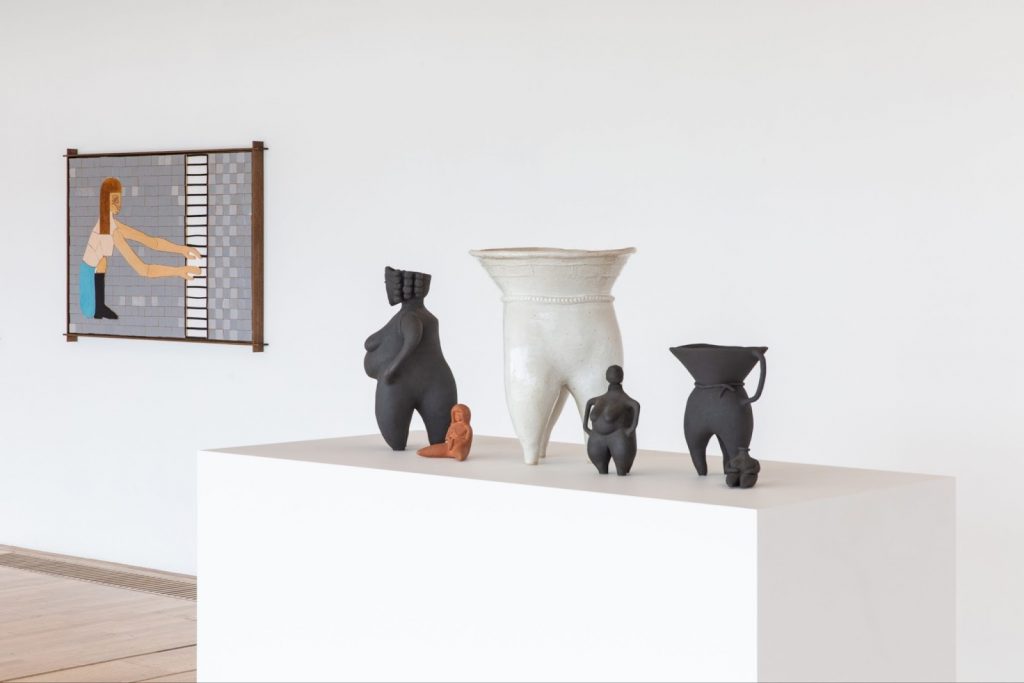CAMPLE LINE is pleased to announce an exhibition of new work by artist Renee So – Effigies and Elginisms – which takes place from 2 April- 19 June 2022 and includes sculpture, stoneware, glazed ceramic tile and textiles which respond to CAMPLE LINE’s spaces.
It is the first solo presentation of So’s work in Scotland. Renee’s work spans numerous traditional craft traditions including ceramics, hand-woven textiles and furniture that refer specifically to representations of the female figure in prehistoric cultures.
She draws upon a wide array of material culture, from 16th and 17th century stoneware, Roman busts, Assyrian sculpture and reliefs, ancient vessels from China, pre-Columbian figurines, Egyptian female goddesses, and modernist textiles designed by the Bauhaus. Her interest in figurative traditions and narratives also embraces portraiture, cartoon and caricature.
So has spoken previously of a focus in her work around representations of the male figure throughout history, with a particular attention to beards, pipes, cigarettes, boots, wigs and hats as signifiers or props by which men projected status and power, and to sources such as the Bellarmine Jar. Her recent work by contrast has also marked a new concentration on traditions of representation of the female form, drawing on 5000 year old Valdivian figures that are specific to Ecuador’s southwest coast and the earliest known ceramic figurine tradition in the Americas, as well as other prehistoric female figures.
For CAMPLE LINE So continues to draw on a wide range of references, from an archaic Parisian by-law, to prehistoric female figurines (Effigies), and items looted from the Old Summer Palace in Beijing in 1860, during the Second Opium War, by French and British Troops under the direction of James Bruce, 8th Earl of Elgin and High Commissioner to China and son of Thomas Bruce, 7th Lord Elgin (Elginisms).
Anchoring the exhibition are a group of stoneware sculptures in black unfired clay. Amongst the grouping are three female figures and the figure of a mythical beast that So has described as part dog, part bird, and part woman, inspired by Assyrian winged lions and Anubis, the Egyptian dog-god.
As So explains, the female figures ‘are inspired by figurative pre-historic pottery and the parallel history of Venus figures which are the earliest representations of the female body. No one knows why they were made, but they are usually small, and can fit in the palm of one’s hand. They are widely believed to be good luck charms for fertility. They were usually made from clay, stone or ivory and feature in ancient South American, African, Egyptian and European cultures.’
So’s female forms draw on Valdivian figures, with their elaborate, often stylised coiffures, as well as ancient predynastic Egyptian figurines, such as those excavated at El Ma’mariya in Egypt that feature abstracted beak-like faces on long necks. Their distinctive tripod stance derives from So’s longstanding interest in ancient Chinese ceramic vessels that feature three hollow bulging legs.
For So, the elongated head and breast forms in her figures also relate to 3-D modelling of the anatomy of the clitoris by Professor of Urology Helen O’Connell. As So has said: ‘It was first mapped in 2016 based on the research by urologist Helen O’Connell who published her studies in 1998…It instantly reminded me of the ancient Egyptian Venus figures yet they are several millennia apart.’
A new series of hand-made, brightly glazed ceramic tiles reliefs echo these forms and humorously play with the associations further, as does a small painting. An additional tile relief features two anthropomorphised vessels – a cup and a jug. So has said that her first tile reliefs in 2018 took inspiration from Neo Assyrian stone carved relief as well as the tiled murals in London’s Underground stations and the glazed brick bas-relief of the Babylonian Ishtar Gate (c. 575 BC).
A group of four glazed sculptures draw in wider references still. A vessel fashioned to look like a pair of trousers relates to the repealing in 2013 of a 213-year-old law banning women in Paris from wearing trousers. Its near companions evoke items that were once part of the Chinese Imperial collection: a stout glazed four-legged bowl form based on Emperor Qianlong’s ornate Zuo Bao Yi Gui, an archaic bronze ritual food ‘gui’, alongside a glazed snuff bottle and Scholars stone, examples of which have found their way in to private and public collections around the world.
Alongside these, So will include an arrangement of dried opium poppies in a vessel of three stacked opium balls, which refer to the opium factories of the East India Company and to a 19th century Punch cartoon depicting James Bruce, entitled ‘New Elgin Marbles’. So will also install a new hand-made textile, constructed using the traditional Korean Pojagi patchwork technique.






